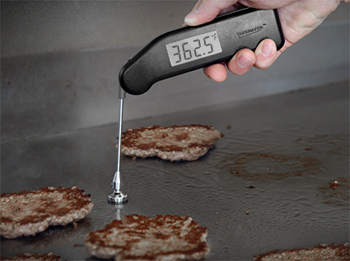Find Your Perfect Griddle Temperature
with the Pro-Surface Thermapen
 Cooking meat on a griddle has distinct advantages over other methods. More food surface is in direct contact with the heat source, which triggers more browning. This browning is what gives you a tantalizing crust and mouth-watering aromas resulting in more flavorful food.
Cooking meat on a griddle has distinct advantages over other methods. More food surface is in direct contact with the heat source, which triggers more browning. This browning is what gives you a tantalizing crust and mouth-watering aromas resulting in more flavorful food.
Achieving just the right amount of browning starts with just the right amount of heat. While browning becomes noticeable at 310°F (154°C), caramelization (i.e. the denaturation of proteins) doesn't happen until temperatures reach between 320 to 400°F (160 to 204°C), and then doesn't produce rich flavors until it reaches mid-range temperatures of 356 to 370°F (180-188°C).
This chemical reaction is what's referred to as the Maillard Reaction. Extreme heat causes proteins and sugars to breakdown (denature). Colors, flavors and aromas are the tell-tale sign that denaturation is happening.
When a griddle's temperature is set too low (300-320°F), food will have to spend more time in contact with the heat to achieve this chemical reaction, which will certainly result in overcooking in the middle. Setting temperatures too high will cause overcooking (or burning) on the surface, while undercooking the center.
For some, a perfectly cooked piece of red meat is cooked so that the outer crust reaches at least 310°F (155°C) during cooking while interior temperatures remain closer to 135°F (57°C). Visual browning on the surface will confirm that your outer surface has reached temps in excess of 310°F, and a good digital thermometer will verify your meats internal temperature.
For perfect outer caramelization and internal doneness set your griddle between 350 and 375°F. Using a device like the Pro-Surface Thermapen®, allows you to measure temperature readings across the surface of the griddle and check for any hot and cold zones. Avoid these areas as best you can to curb uneven cooking, and ensure the quality of food is consistent. The Pro-Surface Thermapen's unique bell-shaped probe lies flat on the griddle surface and gives you an accurate reading (±0.7°F) in only 3 seconds.
Identifying the right griddle temperature to achieve the perfect combination of caramelization without overcooking can be tricky. Managing time and temperature is a balancing act between achieving some reactions in some portions of the meat and other reactions in others. Next time you fire up your griddle maximize your food's flavor potential by adhering to these correct temperature principles.
